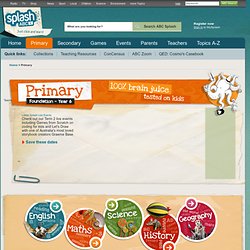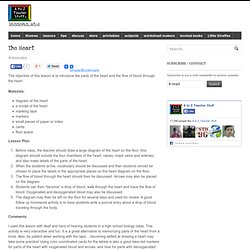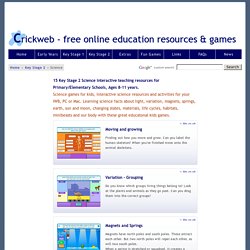

Part_7_Circulatory_System. Emaths - Key Stage 2 (KS2) SAT Past Papers. Science PowerPoints / Lessons / Units for Educators and Homeschool Parents. Amazing Space. Space for Teachers. Primary - ABC Splash. Home > Primary Teachers' area Latest Splash Live Events Check out our Term 2 live events including Games from Scratch on coding for kids and Let's Draw with one of Australia's most loved storybook creators Graeme Base.

Save these dates Watch, listen, play 558 Items for primary: Send me more stuff like this! Sign up for the ABC Splash fortnightly newsletter so you can find out about the new resources we add every day. Explore ABC Splash Watch, listen and play videos, audio clips and games. Follow us: About ABC Splash Games Live Events Primary Collections ABC Zoom Secondary Teaching resources QED: Cosmo's Casebook Parents Teachers FAQs Contact us Topics A-Z House Rules. The Heart. The objective of this lesson is to introduce the parts of the heart and the flow of blood through the heart.

Materials: diagram of the hearta model of the heartmasking tapemarkerssmall pieces of paper or indexcardsfloor space Lesson Plan: Before class, the teacher should draw a large diagram of the heart on the floor (this diagram should include the four chambers of the heart, valves, major veins and arteries) and also make labels of the parts of the heart.When the students arrive, vocabulary should be discussed and then students should be chosen to place the labels in the appropriate places on the heart diagram on the floor.The flow of blood through the heart should then be discussed.
Arrows may also be placed on the diagram.Students can then “become” a drop of blood, walk through the heart and trace the flow of blood. Comments: I used this lesson with deaf and hard of hearing students in a high school biology class. How the Body Works Main Page. Educational Video to teach Body Parts. Body parts preschool lesson plan - free ebook downloads.
The Pink Locker Society. Science - General / Investigative Teaching Ideas. Science. KS2 Science. Finding out how you move and grow.

Can you label the human skeleton? When you've finished move onto the animal skeletons. Do you know which groups living things belong to? Look at the plants and animals as they go past. Can you drag them into the correct groups? Magnets have north poles and south poles. What does a year look like in space? © v2vtraining.co.uk The application consists of two sorting activities and one writing frame to support work towards the end of the unit.
Solid, liquid and gas are called the three states of matter. Materials have different properties that make them useful for different jobs. Pupils can research information about teeth types, tooth structure and tooth decay. Use an information panel where pupils can research details about food groups and a balanced plate approach to a healthy diet.Balanced Plate lesson outline An information panel to explains the terms used in, and concepts behind, food chains. Schools - Teachers - Science - KS2 lesson plans. Exercise, Fitness and Nutrition Lesson Plans for Teachers. Learning Zone Class Clips - Solids and liquids - Science Video. Types of Forces. Science - Forces Teaching Ideas.